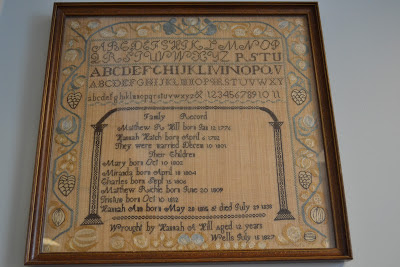Since last I wrote, I have had the opportunity to visit and borrow needlework from the Pejepscot Historical Society in Brunswick, Maine and the Lincoln County Historical Society in Wiscasset, Maine, both coastal communities "downeast" of Portland. I knew I was borrowing from Pejepscot a sampler that was made, (according to the very early label on the back written by the sampler maker's daughter,) at Miss Hall's Infant School in Portland. Tracking down Miss Hall has so far eluded me. There was Martha Hall that appeared on the 1830 census as a head of household in Portland. A clue? Maybe, or maybe not. There were several male Hall heads of household in Portland that year, as well, and Miss Hall may have been the daughter of any of them.
But I came away from the Pejepscot's museum with a fabulous (totally unexpected!) example stitched by Frances Niles, probably made in Topsham, Maine. She had to add her name and verse sideways when she ran out of room on her meticulously stitched sampler. Or maybe she planned it that way all along? It doesn't match with any others I've seen so far. For another (unrelated) example of sideways stitching, see below.
Another recent and exciting discovery is of a sampler owned by Strawbery Banke, and being loaned for the exhibit. We were already borrowing a sampler owned by the Wells Public Library, which was the only one of its style I had seen. It turns out that there is ample evidence that the Strawbery Banke piece was stitched under the instruction of the same teacher.
The upper one is from the Wells Public Library. Take a look at the alphabets on both and the use of the black narrow border seen at the bottom of the upper sampler and throughout the second one. They are both spectacular and document an issue (question?) that I have previously reffered to when discussing Portland samplers. How similar do two peices have to be to attribute them to the same school? In Portland, that is a complicated question because there were many teachers with very closely related styles. Wells is a much smaller place; to date I have found no advertisements for female academies there, but these two works have enough features in common to make it highly likely that the same still-anonymous instructor taught both girls.The most important thing to come to light in the last month, however, was that we were notified by the Coby Foundation, Ltd., of New York City that we would be receiving a grant of $18,000 in support of the exhibit and publication. That piece of news made me cry. The Saco Museum is not a large place. Between the Dyer Library and Saco Museum--both run by the non-profit Dyer Library Association--we have a staff of twenty. Most of those work at the library. The museum has only two full-time staff members. This exhibit would have gone forward, no matter whether we received any grant to support for it or not, but having the backing of the prestigious Coby Foundation not only seems like recognition for the hard, in depth work we are doing, but also means that we can do a better job.
Here is what the Coby Foundation says about itself on the website:
The Coby Foundation, Ltd., located in New York City, funds projects in the textile and needle arts field. Its funding is limited to non-profit organizations in the Mid-Atlantic and New England.
The Coby Foundation was established in 1994 by Irene Zambelli Silverman in honor of her mother, Irene Meladakis Zambelli. Mrs. Silverman described her mother as "the finest needlewoman in New York."
The majority of the Coby Foundation's support goes to exhibitions and education programs that combine excellent scholarship and effective interpretation. Projects may be in the arts or humanities, contemporary or historical, but all must have a public benefit. Such projects may include research and documentation, conservation, publication and Web projects. The Foundation supports only the direct costs of projects.
We are very grateful to Lynne Anderson for telling us about the foundation's work. We are thrilled to receive a grant from the Coby Foundation.

